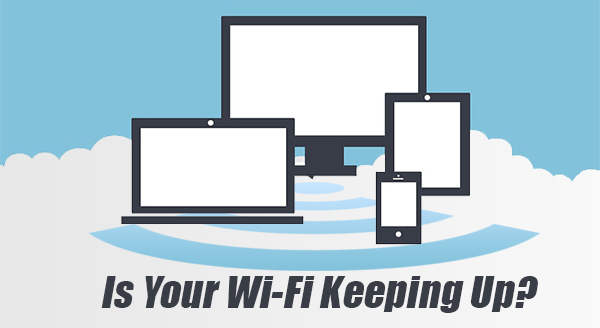 Wi-Fi has forever changed the way we live, work and play. We can surf the internet on the couch or by the pool, look up a recipe in an instant, and even connect our lights to voice control. It’s no wonder it was accepted with open arms, but is your Wi-Fi as good as it needs to be?
Wi-Fi has forever changed the way we live, work and play. We can surf the internet on the couch or by the pool, look up a recipe in an instant, and even connect our lights to voice control. It’s no wonder it was accepted with open arms, but is your Wi-Fi as good as it needs to be?
15 years after Wi-Fi first made its way into homes with those mysterious rabbit-eared boxes, it’s evolved into a juggernaut of speed and accessibility that we can’t do without. Think about how many wireless devices your home has – the average home has at least 10 devices connected wirelessly to the internet, many have more.
While older devices are typically happy with a small slice of your internet, newer devices like 4kTVs and media streaming simply can’t function without a fast connection. Add in a game console, tablet, a few smartphones and a laptop or two, and your Wi-Fi is suddenly stretched beyond full capacity and struggling to keep up. Yet, most people don’t know how fast their Wi-Fi is, or if it’s working right– they only know how many bars they’ve got. Unfortunately, counting bars can add up to one big headache.
Here’s why your WiFi may be letting you down:
Bars measure the wrong thing: While it’s great to know you’ve got a ‘strong’ signal, it would be even better if you could have a ‘fast and available’ signal. The internet could actually be down and you’d still have full bars because it’s really only measuring how close to the Wi-Fi router you are. That proximity measure doesn’t take into account how many devices are fighting for the same bandwidth or whether there’s any left for you. We can ensure your Wi-Fi isn’t just available, it’s up to the task.
Wi-Fi goes sideways too: While your neighbor’s Wi-Fi can reach the back of their property, it can also go a similar distance sideways into your house. This extra ‘noise’ can disrupt and slow down your own Wi-Fi. In dense areas, your Wi-Fi is basically getting lost in a swirling field of signals, all using the same channel and frequency. It’s a digital crowd which can seriously slow your speeds. We can fix this by changing your Wi-Fi channel to one with less cross-talk.
Everyone uses the default settings: Most home Wi-Fi uses a 2.4ghz frequency by default. While it makes a plug & play router easy to set up, it does mean you’re not getting the speeds you could be. Switching to the 5ghz frequency means your Wi-Fi is separated from the neighborhood cross-talk. The 5ghz band is also considerably faster, which is a bonus but it has its drawbacks too. We can help you upgrade to a newer 5Ghz-capable router that can provide both frequency bands and automatically switch your device to the best one.
Your house is too big: WiFi radios are limited in transmission power by the FCC. As such, even the fanciest most powerful router can only reach so far. Likewise, even if your super-powerful router can broadcast to the edges of your property, your device may not be strong enough to send a signal back. Sometimes people’s solution to this is to purchase another router (setting up two networks which are cumbersome at best), or adding an off-the-shelf repeater (which isn’t a great solution either). Instead of going down that patch of a segmented unstable network, there are systems for sale that actually allow you to have a seamless single network through your home. These types of networks are called ‘Mesh’ networks, and when implemented properly they can GREATLY increase the coverage and performance of your network.
Priority isn’t set: While not Wi-Fi specific, we can also set up “Quality of Service” if your router supports it or supply you with one that does. This allows things like Netflix and Skype calls to always take priority and remain uninterrupted over less important tasks like downloads. You’ll be able to watch movies without those awful buffering jumps and video chat without freezing.



